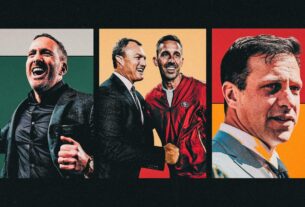Ed Cubberly had never heard of Anthony Hopkins when he received a phone call from Kathleen Gerlach, the assistant costume designer on a movie he knew nothing about. It was 1989, and the film version of “The Silence of the Lambs” was two years from becoming a critical and commercial sensation.
Cubberly, a full-time nurse at the time, living in Bayonne, New Jersey, had a side business making masks for NHL goalies from 1988 to 2000. Mike Richter, Frank Pietrangelo and Mark Fitzpatrick were among the players who wore his products.
So how did he get drawn in to help create one of film’s all-time villains?
At one point in the late 1980s, Cubberly left a business card at Gerry Cosby & Co. Sporting Goods in Manhattan. Not long after, members of the “The Silence of the Lambs” prop department went to the shop looking for a mask. They walked away with Cubberly’s contact information.
Gerlach reached out to Cubberly about making a mask — not for hockey but for what would become a classic scene in the movie. And thus began Cubberly’s lone foray into film and his connection to Anthony Hopkins’ portrayal of Hannibal Lecter, who the American Film Institute ranks as the No. 1 movie villain of all time.
“My 15 minutes of fame,” Cubberly says now. “I guess it turned out OK.”
Midway through “Silence of the Lambs,” Lecter speaks to a senator while strapped to a gurney. He is a serial killer notorious for eating his victims, but he’s also a brilliant psychiatrist with information that could help catch another serial killer, Buffalo Bill. As he speaks to the senator, whose daughter has been kidnapped by Buffalo Bill, he wears a straight jacket and a fiberglass mask that covers his nose and the lower half of his face.
There’s an opening over his mouth covered by three metal bars — a measure against a potential cannibalistic outburst.
That was Cubberly’s finished product: the most famous mask he ever made, with all due respect to the Statue of Liberty mask that New York Rangers goalie Mike Richter wore in the 1994 Stanley Cup Final.
“It was kind of devious and scary looking,” says Cubberly, now 67. “It fit the scene perfectly.”
When enlisting Cubberly’s help, Gerlach gave him a description of the scene. Cubberly came up with the concept in only a few minutes, using a Sharpie to draw the design on a picture of one of his old masks. He interpreted Gerlach’s instructions as instructions to give Lecter a muzzle, which led to the mouth covering. He also added a pair of holes over the nostrils.
Cubberly was in contact with Gerlach and future Academy Award-winning costume designer Colleen Atwood throughout the process. At one point, they asked what he was thinking for the mask’s color. Cubberly suggested keeping the fiberglass’s greenish-tan shade. It would look like something that could have been made in jail, he told them. Director Jonathan Demme loved the idea, Cubberly recalls.
“I was just trying to get out of painting the thing,” he says with a chuckle.
Cubberly never met Hopkins, who won an Oscar for his performance. The film’s prop crew mailed him a plaster mold of the actor’s face, which he still has. Cubberly sculpted clay over the mold, then built the fiberglass mask over the clay. The process took only a couple of days.
The costume department had Hopkins try out different types of masks before filming. One looked like a beekeeper’s mask. Others were more cage-like. Cubberly’s design proved most effective.
“It looked nothing like any of the other masks,” he says.
The scene is similarly unique — and tense. Dramatic string music plays as Lecter is wheeled forward, and Hopkins makes piercing eye contact with the senator as he toys with her throughout the conversation.
Cubberly doesn’t watch many movies, but he and his wife went to “The Silence of the Lambs” when it came out in theaters. He didn’t know exactly when his mask would make an appearance. The second it did, he jumped from his seat and let out a cheer.
The other patrons hissed at him to sit down.
“I made that mask for the movie!” he told them.
No one in the theater believed him. Why would they think the mask came from New Jersey?
Cubberly, who now lives in Frenchtown, New Jersey, received $400 in payment for the mask. He also maintains copyright over the design. That’s gotten him some extra cash over the years. He’s signed contracts with Halloween costume companies allowing them to reproduce the mask.
Billy Crystal wore the original while hosting the Oscars in 1992, making a joke that he looked like the goalie from the Screen Actors Guild hockey team.
Cubberly hasn’t seen the original in person since he shipped it from New Jersey to Pittsburgh, where most of the movie was filmed.
“It’s a question I get all the time,” he says. “I have no idea where it is.”
He does, however, have a gift from the man who wore it. After making the mask, he asked the film’s prop crew if he could get something signed by Hopkins. They granted the request, mailing him a photo of Hopkins wearing the mask. He keeps the photo framed on his wall.
“To Eddie,” Hopkins scrawled at the bottom of the picture, “All good wishes — and be very careful on dark nights, Eddie, because I’ll be waiting and watching.”
Hopkins signed the picture twice: once with his own name and once with the name of the character Cubberly helped give his iconic look: Dr. Lecter.
(Top photo: Rodin Eckenroth / Getty Images)






